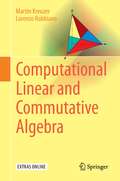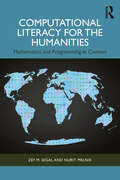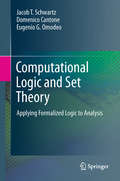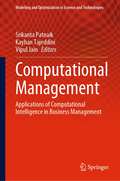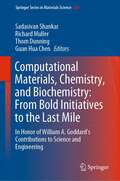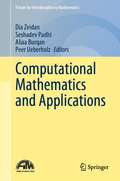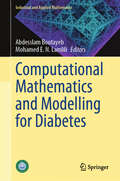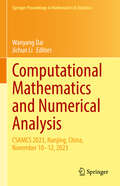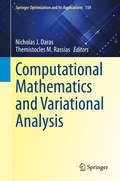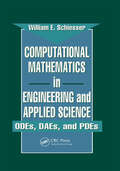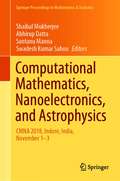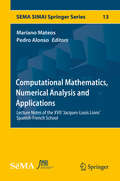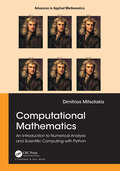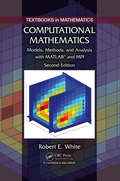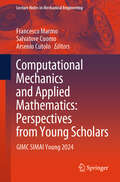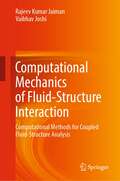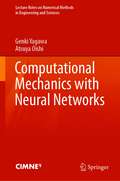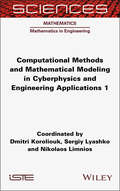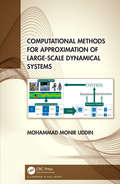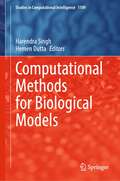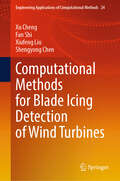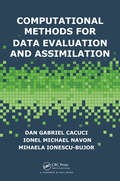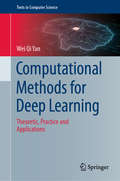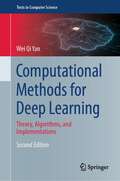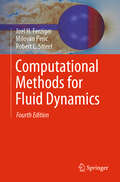- Table View
- List View
Computational Linear and Commutative Algebra
by Martin Kreuzer Lorenzo RobbianoThis book combines, in a novel and general way, an extensive development of the theory of families of commuting matrices with applications to zero-dimensional commutative rings, primary decompositions and polynomial system solving. It integrates the Linear Algebra of the Third Millennium, developed exclusively here, with classical algorithmic and algebraic techniques. Even the experienced reader will be pleasantly surprised to discover new and unexpected aspects in a variety of subjects including eigenvalues and eigenspaces of linear maps, joint eigenspaces of commuting families of endomorphisms, multiplication maps of zero-dimensional affine algebras, computation of primary decompositions and maximal ideals, and solution of polynomial systems. This book completes a trilogy initiated by the uncharacteristically witty books Computational Commutative Algebra 1 and 2 by the same authors. The material treated here is not available in book form, and much of it is not available at all. The authors continue to present it in their lively and humorous style, interspersing core content with funny quotations and tongue-in-cheek explanations.
Computational Literacy for the Humanities: Mathematics and Programming in Context
by Zef Segal Nurit MelnikComputational Literacy for the Humanities provides an introduction to mathematics and programming that is specifically designed for use by those engaged in the humanities. Linking mathematical concepts and computational skills, the chapters in this book explore humanistic questions from diverse fields, such as art, history and literature.The book helps to advance computational and digital literacy by showing that each mathematical concept has a history, and each technique has a meaning. Rather than viewing mathematics and computer programming as purely instrumental, they are integrated into the process of achieving greater understanding of humanistic phenomena. Algorithms, data, statistics and networks are taught critically within the book, whilst the authors also make a concerted effort to expose the internal biases of these tools. They also demonstrate the applicability of quantification and computation for the promotion of diversification and inclusivity within the humanities. All exercises are designed as an opportunity to gain hands-on mathematical and computational experience, whilst critically exploring and interpreting humanistic phenomena.Computational Literacy for the Humanities shows readers how to engage with data in a way that is challenging, yet meaningful and empowering. It will be of interest to scholars and students working across the humanities and should be of particular interest to those working in digital humanities.
Computational Logic and Set Theory: Applying Formalized Logic to Analysis (Texts in Computer Science)
by Martin Davis Domenico Cantone Jacob T. Schwartz Eugenio G. OmodeoThis must-read text presents the pioneering work of the late Professor Jacob (Jack) T. Schwartz on computational logic and set theory and its application to proof verification techniques, culminating in the ÆtnaNova system, a prototype computer program designed to verify the correctness of mathematical proofs presented in the language of set theory. Topics and features: describes in depth how a specific first-order theory can be exploited to model and carry out reasoning in branches of computer science and mathematics; presents an unique system for automated proof verification in large-scale software systems; integrates important proof-engineering issues, reflecting the goals of large-scale verifiers; includes an appendix showing formalized proofs of ordinals, of various properties of the transitive closure operation, of finite and transfinite induction principles, and of Zorn's lemma.
Computational Management: Applications of Computational Intelligence in Business Management (Modeling and Optimization in Science and Technologies #18)
by Vipul Jain Srikanta Patnaik Kayhan TajeddiniThis book offers a timely review of cutting-edge applications of computational intelligence to business management and financial analysis. It covers a wide range of intelligent and optimization techniques, reporting in detail on their application to real-world problems relating to portfolio management and demand forecasting, decision making, knowledge acquisition, and supply chain scheduling and management.
Computational Materials, Chemistry, and Biochemistry: In Honor of William A. Goddard’s Contributions to Science and Engineering (Springer Series in Materials Science #284)
by Richard Muller Thom Dunning Sadasivan Shankar Guan Hua ChenThis book provides a broad and nuanced overview of the achievements and legacy of Professor William (“Bill”) Goddard in the field of computational materials and molecular science. Leading researchers from around the globe discuss Goddard’s work and its lasting impacts, which can be seen in today’s cutting-edge chemistry, materials science, and biology techniques. Each section of the book closes with an outline of the prospects for future developments.In the course of a career spanning more than 50 years, Goddard’s seminal work has led to dramatic advances in a diverse range of science and engineering fields. Presenting scientific essays and reflections by students, postdoctoral associates, collaborators and colleagues, the book describes the contributions of one of the world’s greatest materials and molecular scientists in the context of theory, experimentation, and applications, and examines his legacy in each area, from conceptualization (the first mile) to developments and extensions aimed at applications, and lastly to de novo design (the last mile). Goddard’s passion for science, his insights, and his ability to actively engage with his collaborators in bold initiatives is a model for us all. As he enters his second half-century of scientific research and education, this book inspires future generations of students and researchers to employ and extend these powerful techniques and insights to tackle today’s critical problems in biology, chemistry, and materials. Examples highlighted in the book include new materials for photocatalysts to convert water and CO2 into fuels, novel catalysts for the highly selective and active catalysis of alkanes to valuable organics, simulating the chemistry in film growth to develop two-dimensional functional films, and predicting ligand–protein binding and activation to enable the design of targeted drugs with minimal side effects.
Computational Mathematics and Applications (Forum for Interdisciplinary Mathematics)
by Seshadev Padhi Dia Zeidan Aliaa Burqan Peer UeberholzThis book is a collection of invited and reviewed chapters on state-of-the-art developments in interdisciplinary mathematics. The book discusses recent developments in the fields of theoretical and applied mathematics, covering areas of interest to mathematicians, scientists, engineers, industrialists, researchers, faculty, and students. Readers will be exposed to topics chosen from a wide range of areas including differential equations, integral reforms, operational calculus, numerical analysis, fluid mechanics, and computer science. The aim of the book is to provide brief and reliably expressed research topics that will enable those new or not aware of mathematical sciences in this part of the world.While the book has not been precisely planned to address any branch of mathematics, it presents contributions of the relevant topics to do so. The topics chosen for the book are those that we have found of significant interest to many researchers in the world. These also are topics that are applicable in many fields of computational and applied mathematics. This book constitutes the first attempt in Jordanian literature to scientifically consider the extensive need of research development at the national and international levels with which mathematics deals. The book grew not only from the international collaboration between the authors but rather from the long need for a research-based book from different parts of the world for researchers and professionals working in computational and applied mathematics.
Computational Mathematics and Modelling for Diabetes (Industrial and Applied Mathematics)
by Abdesslam Boutayeb Mohamed E. N. LamliliThis book is a theoretical and pragmatic tool that applies mathematical modelling in understanding and managing diabetes and related complications such as diabetes predisposition, diabetes onset, regular glycaemic monitoring, glycated haemoglobin HbA1c, diabetes homeostasis, gestational diabetes and other associated diseases and conditions. Chapters in the book provide mathematical models dealing with the dynamics of insulin/glucose, the evolution from pre-diabetes to diabetes without and with complications, gestational diabetes and the association between diabetes and benign prostatic hyperplasia. It also applies new methods such as data mining, machine learning and deep learning. By offering pragmatic examples and comprehensive reviews on mathematical models used for diabetes, this book is useful for advanced researchers, academic teachers, students, scientists and high pharmaceutical industry executives willing to start modelling.
Computational Mathematics and Numerical Analysis: CSAMCS 2023, Nanjing, China, November 10–12, 2023 (Springer Proceedings in Mathematics & Statistics #486)
by Jichun Li Wanyang DaiThis book represents the proceedings of the 3rd International Conference on Statistics, Applied Mathematics, and Computing Science (CSAMCS 2023), held from November 10th to 12th, 2023 in Nanjing, China, hosted by Nanjing University. This conference proceedings aims to encapsulate the essence of the conference by featuring papers that discuss topics such as Computational Mathematics and Numerical Analysis. It serves as a repository of research presented at CSAMCS 2023, highlighting the importance and relevance of these fields in tackling contemporary challenges.
Computational Mathematics and Variational Analysis (Springer Optimization and Its Applications #159)
by Nicholas J. Daras Themistocles M. RassiasThis volume presents a broad discussion of computational methods and theories on various classical and modern research problems from pure and applied mathematics. Readers conducting research in mathematics, engineering, physics, and economics will benefit from the diversity of topics covered. Contributions from an international community treat the following subjects: calculus of variations, optimization theory, operations research, game theory, differential equations, functional analysis, operator theory, approximation theory, numerical analysis, asymptotic analysis, and engineering.Specific topics include algorithms for difference of monotone operators, variational inequalities in semi-inner product spaces, function variation principles and normed minimizers, equilibria of parametrized N-player nonlinear games, multi-symplectic numerical schemes for differential equations, time-delay multi-agent systems, computational methods in non-linear design of experiments, unsupervised stochastic learning, asymptotic statistical results, global-local transformation, scattering relations of elastic waves, generalized Ostrowski and trapezoid type rules, numerical approximation, Szász Durrmeyer operators and approximation, integral inequalities, behaviour of the solutions of functional equations, functional inequalities in complex Banach spaces, functional contractions in metric spaces.
Computational Mathematics in Engineering and Applied Science: ODEs, DAEs, and PDEs (Symbolic & Numeric Computation)
by W.E. SchiesserComputational Mathematics in Engineering and Applied Science provides numerical algorithms and associated software for solving a spectrum of problems in ordinary differential equations (ODEs), differential algebraic equations (DAEs), and partial differential equations (PDEs) that occur in science and engineering. It presents detailed examples, each
Computational Mathematics, Nanoelectronics, and Astrophysics: CMNA 2018, Indore, India, November 1–3 (Springer Proceedings in Mathematics & Statistics #342)
by Abhirup Datta Santanu Manna Shaibal Mukherjee Swadesh Kumar SahooThis book is a collection of original papers presented at the International Conference on Computational Mathematics in Nanoelectronics and Astrophysics (CMNA 2018) held at the Indian Institute of Technology Indore, India, from 1 to 3 November 2018. It aims at presenting recent developments of computational mathematics in nanoelectronics, astrophysics and related areas of space sciences and engineering. These proceedings discuss the most advanced innovations, trends and real-world challenges encountered and their solutions with the application of computational mathematics in nanoelectronics, astrophysics and space sciences. From focusing on nano-enhanced smart technological developments to the research contributions of premier institutes in India and abroad on ISRO’s future space explorations—this book includes topics from highly interdisciplinary areas of research. The book is of interest to researchers, students and practising engineers working in diverse areas of science and engineering, ranging from applied and computational mathematics to nanoelectronics, nanofabrications and astrophysics.
Computational Mathematics, Numerical Analysis and Applications: Lecture Notes of the XVII 'Jacques-Louis Lions' Spanish-French School (SEMA SIMAI Springer Series #13)
by Pedro Alonso Mariano MateosThe first part of this volume gathers the lecture notes of the courses of the "XVII Escuela Hispano-Francesa", held in Gij#65533;n, Spain, in June 2016. Each chapter is devoted to an advanced topic and presents state-of-the-art research in a didactic and self-contained way. Young researchers will find a complete guide to beginning advanced work in fields such as High Performance Computing, Numerical Linear Algebra, Optimal Control of Partial Differential Equations and Quantum Mechanics Simulation, while experts in these areas will find a comprehensive reference guide, including some previously unpublished results, and teachers may find these chapters useful as textbooks in graduate courses. The second part features the extended abstracts of selected research work presented by the students during the School. It highlights new results and applications in Computational Algebra, Fluid Mechanics, Chemical Kinetics and Biomedicine, among others, offering interested researchers a convenient reference guide to these latest advances.
Computational Mathematics: An introduction to Numerical Analysis and Scientific Computing with Python (Advances in Applied Mathematics)
by Dimitrios MitsotakisThis textbook is a comprehensive introduction to computational mathematics and scientific computing suitable for undergraduate and postgraduate courses. It presents both practical and theoretical aspects of the subject, as well as advantages and pitfalls of classical numerical methods alongside with computer code and experiments in Python. Each chapter closes with modern applications in physics, engineering, and computer science. Features: No previous experience in Python is required. Includes simplified computer code for fast-paced learning and transferable skills development. Includes practical problems ideal for project assignments and distance learning. Presents both intuitive and rigorous faces of modern scientific computing. Provides an introduction to neural networks and machine learning.
Computational Mathematics: Models, Methods, and Analysis with MATLAB and MPI, Second Edition (Textbooks In Mathematics Ser.)
by Robert E. WhiteComputational Mathematics: Models, Methods, and Analysis with MATLAB and MPI is a unique book covering the concepts and techniques at the core of computational science. The author delivers a hands-on introduction to nonlinear, 2D, and 3D models; nonrectangular domains; systems of partial differential equations; and large algebraic problems requirin
Computational Mechanics and Applied Mathematics: GIMC SIMAI Young 2024 (Lecture Notes in Mechanical Engineering)
by Francesco Marmo Salvatore Cuomo Arsenio CutoloThis book collects the latest advances and innovations in the field of applied mathematics and computational mechanics, as presented at the 2nd Workshop GIMC SIMAI YOUNG, held in Naples, Italy, on July 10–12, 2024. The workshop was the joint effort of Computational Mechanics Group of the Italian Association of Theoretical and Applied Mechanics -AIMETA (GIMC) and Italian Society of Applied and Industrial Mathematics (SIMAI) and was meant to highlight the works of young researchers in the field. Topics include mathematical models for socio-epidemiological dynamics, efficient numerical methods for evolutionary PDEs, multi-scale approaches and machine learning techniques in material modelling, nonlinear material behaviour, computational methods for shells and spatial structures, assessment, monitoring, and design of masonry structures, particles in numerical simulations, non-Newtonian complex fluids, mathematical modelling in mechanobiology and oncology, mechanics of biological systems and bioinspired materials, computational approaches for complex dynamical systems, optimization methods for classical and data-driven approaches. The contributions, which were selected by means of a rigorous peer-review process, present a wealth of exciting ideas that will open novel research directions and foster multidisciplinary collaboration.
Computational Mechanics of Fluid-Structure Interaction: Computational Methods for Coupled Fluid-Structure Analysis
by Rajeev Kumar Jaiman Vaibhav JoshiThis book is intended to provide a compilation of the state-of-the-art numerical methods for nonlinear fluid-structure interaction using the moving boundary Lagrangian-Eulerian formulation. Single and two-phase viscous incompressible fluid flows are considered with the increasing complexity of structures ranging from rigid-body, linear elastic and nonlinear large deformation to fully-coupled flexible multibody system. This book is unique with regard to computational modeling of such complex fluid-structure interaction problems at high Reynolds numbers, whereby various coupling techniques are introduced and systematically discussed. The techniques are demonstrated for large-scale practical problems in aerospace and marine/offshore engineering. This book also provides a comprehensive understanding of underlying unsteady physics and coupled mechanical aspects of the fluid-structure interaction from a computational point of view. Using the body-fitted and moving mesh formulations, the physical insights associated with structure-to-fluid mass ratios (i.e., added mass effects), Reynolds number, large structural deformation, free surface, and other interacting physical fields are covered. The book includes the basic tools necessary to build the concepts required for modeling such coupled fluid-structure interaction problems, thus exposing the reader to advanced topics of multiphysics and multiscale phenomena.
Computational Mechanics with Neural Networks (Lecture Notes on Numerical Methods in Engineering and Sciences)
by Genki Yagawa Atsuya OishiThis book shows how neural networks are applied to computational mechanics. Part I presents the fundamentals of neural networks and other machine learning method in computational mechanics. Part II highlights the applications of neural networks to a variety of problems of computational mechanics. The final chapter gives perspectives to the applications of the deep learning to computational mechanics.
Computational Methods and Mathematical Modeling in Cyberphysics and Engineering Applications 1
by Nikolaos Limnios Dmitri Koroliouk Sergiy LyashkoMathematical methods in engineering are characterized by a wide range of techniques for approaching various problems. Moreover, completely different analysis techniques can be applied to the same problem, which is justified by the difference in specific applications. Therefore, the study of the analyses and solutions of specific problems leads the researcher to generate their own techniques for the analysis of similar problems continuously arising in the process of technical development. Computational Methods and Mathematical Modeling in Cyberphysics and Engineering Applications contains solutions to specific problems in current areas of computational engineering and cyberphysics.
Computational Methods for Approximation of Large-Scale Dynamical Systems
by Mohammad Monir UddinThese days, computer-based simulation is considered the quintessential approach to exploring new ideas in the different disciplines of science, engineering and technology (SET). To perform simulations, a physical system needs to be modeled using mathematics; these models are often represented by linear time-invariant (LTI) continuous-time (CT) systems. Oftentimes these systems are subject to additional algebraic constraints, leading to first- or second-order differential-algebraic equations (DAEs), otherwise known as descriptor systems. Such large-scale systems generally lead to massive memory requirements and enormous computational complexity, thus restricting frequent simulations, which are required by many applications. To resolve these complexities, the higher-dimensional system may be approximated by a substantially lower-dimensional one through model order reduction (MOR) techniques. Computational Methods for Approximation of Large-Scale Dynamical Systems discusses computational techniques for the MOR of large-scale sparse LTI CT systems. Although the book puts emphasis on the MOR of descriptor systems, it begins by showing and comparing the various MOR techniques for standard systems. The book also discusses the low-rank alternating direction implicit (LR-ADI) iteration and the issues related to solving the Lyapunov equation of large-scale sparse LTI systems to compute the low-rank Gramian factors, which are important components for implementing the Gramian-based MOR. Although this book is primarly aimed at post-graduate students and researchers of the various SET disciplines, the basic contents of this book can be supplemental to the advanced bachelor's-level students as well. It can also serve as an invaluable reference to researchers working in academics and industries alike. Features: Provides an up-to-date, step-by-step guide for its readers. Each chapter develops theories and provides necessary algorithms, worked examples, numerical experiments and related exercises. With the combination of this book and its supplementary materials, the reader gains a sound understanding of the topic. The MATLAB® codes for some selected algorithms are provided in the book. The solutions to the exercise problems, experiment data sets and a digital copy of the software are provided on the book's website; The numerical experiments use real-world data sets obtained from industries and research institutes.
Computational Methods for Biological Models (Studies in Computational Intelligence #1109)
by Hemen Dutta Harendra SinghThis book discusses computational methods related to biological models using mathematical tools and techniques. The book chapters concentrate on numerical and analytical techniques that provide a global solution for biological models while keeping long-term benefits in mind. The solutions are useful in closely understanding biological models, and the results will be very useful for mathematicians, engineers, doctors, scientists and researchers working on real-life biological models. This book provides significant and current knowledge of biological models related to real-life applications. The book covers both methods and applications.
Computational Methods for Blade Icing Detection of Wind Turbines (Engineering Applications of Computational Methods #24)
by Xiufeng Liu Shengyong Chen Xu Cheng Fan ShiThis book thoroughly explores the realm of data-driven blade-icing detection for wind turbines, focusing on multivariate time series classification to enhance the reliability and efficiency of wind energy utilization. The widespread prevalence of sensor technology in wind turbines, coupled with substantial data collection, has paved the way for advanced data-driven methodologies, which do not require extensive domain knowledge or additional mechanical tools. The interdisciplinary appeal of this study has drawn attention from experts in fields like computer science, mechanical engineering, and renewable energy systems. Adopting a comprehensive approach, the book lays down a foundational framework for blade-icing detection, stressing the critical role of sensor data integration and the profound impact of machine learning techniques in refining the detection processes. The book is designed for undergraduate and graduate students keen on renewable energy technologies, researchers delving into machine learning applications in energy systems, and engineers focusing on sustainable solutions for enhancing wind turbine performance.
Computational Methods for Data Evaluation and Assimilation
by Dan Gabriel Cacuci Ionel Michael Navon Mihaela Ionescu-BujorData evaluation and data combination require the use of a wide range of probability theory concepts and tools, from deductive statistics mainly concerning frequencies and sample tallies to inductive inference for assimilating non-frequency data and a priori knowledge. Computational Methods for Data Evaluation and Assimilation presents interdiscipli
Computational Methods for Deep Learning: Theoretic, Practice and Applications (Texts in Computer Science)
by Wei Qi YanIntegrating concepts from deep learning, machine learning, and artificial neural networks, this highly unique textbook presents content progressively from easy to more complex, orienting its content about knowledge transfer from the viewpoint of machine intelligence. It adopts the methodology from graphical theory, mathematical models, and algorithmic implementation, as well as covers datasets preparation, programming, results analysis and evaluations.Beginning with a grounding about artificial neural networks with neurons and the activation functions, the work then explains the mechanism of deep learning using advanced mathematics. In particular, it emphasizes how to use TensorFlow and the latest MATLAB deep-learning toolboxes for implementing deep learning algorithms.As a prerequisite, readers should have a solid understanding especially of mathematical analysis, linear algebra, numerical analysis, optimizations, differential geometry, manifold, and information theory, as well as basic algebra, functional analysis, and graphical models. This computational knowledge will assist in comprehending the subject matter not only of this text/reference, but also in relevant deep learning journal articles and conference papers.This textbook/guide is aimed at Computer Science research students and engineers, as well as scientists interested in deep learning for theoretic research and analysis. More generally, this book is also helpful for those researchers who are interested in machine intelligence, pattern analysis, natural language processing, and machine vision.Dr. Wei Qi Yan is an Associate Professor in the Department of Computer Science at Auckland University of Technology, New Zealand. His other publications include the Springer title, Visual Cryptography for Image Processing and Security.
Computational Methods for Deep Learning: Theory, Algorithms, and Implementations (Texts in Computer Science)
by Wei Qi YanThe first edition of this textbook was published in 2021. Over the past two years, we have invested in enhancing all aspects of deep learning methods to ensure the book is comprehensive and impeccable. Taking into account feedback from our readers and audience, the author has diligently updated this book. The second edition of this textbook presents control theory, transformer models, and graph neural networks (GNN) in deep learning. We have incorporated the latest algorithmic advances and large-scale deep learning models, such as GPTs, to align with the current research trends. Through the second edition, this book showcases how computational methods in deep learning serve as a dynamic driving force in this era of artificial intelligence (AI). This book is intended for research students, engineers, as well as computer scientists with interest in computational methods in deep learning. Furthermore, it is also well-suited for researchers exploring topics such as machine intelligence, robotic control, and related areas.
Computational Methods for Fluid Dynamics
by Joel H. Ferziger Milovan Perić Robert L. StreetThis book is a guide to numerical methods for solving fluid dynamics problems. The most widely used discretization and solution methods, which are also found in most commercial CFD-programs, are described in detail. Some advanced topics, like moving grids, simulation of turbulence, computation of free-surface flows, multigrid methods and parallel computing, are also covered. Since CFD is a very broad field, we provide fundamental methods and ideas, with some illustrative examples, upon which more advanced techniques are built. Numerical accuracy and estimation of errors are important aspects and are discussed in many examples. Computer codes that include many of the methods described in the book can be obtained online. This 4th edition includes major revision of all chapters; some new methods are described and references to more recent publications with new approaches are included. Former Chapter 7 on solution of the Navier-Stokes equations has been split into two Chapters to allow for a more detailed description of several variants of the Fractional Step Method and a comparison with SIMPLE-like approaches. In Chapters 7 to 13, most examples have been replaced or recomputed, and hints regarding practical applications are made. Several new sections have been added, to cover, e.g., immersed-boundary methods, overset grids methods, fluid-structure interaction and conjugate heat transfer.
